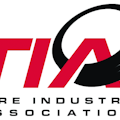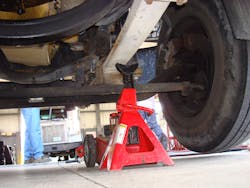Do you know what is the most serious risk to technicians?
After training more than 40,000 people on the proper procedures for servicing truck tires and wheels, the TIA has come to the conclusion that most technicians appear to be aware of the risks.
They will nod their heads in unanimous approval when we tell them that inflating a truck tire is inherently dangerous so it should always take place in a restraining device. They will also swear up and down that the inflation devices used to inflate truck tires always comply with Occupational Safety and Health Administration (OSHA) regulations.
Regardless of whether they are being honest or not, we are equally confident that watching the air from a “zipper rupture” disintegrate a mannequin positioned next to the sidewall is enough to convince most of them that there is some degree of risk every time a tire is being inflated.
Even the old-timers have to admit that while they are not nearly as dangerous as the multi-piece assemblies of decades past, a radial truck tire on a single-piece rim is still something that needs to be respected when it’s under pressure.
A Disturbing Trend
Beyond the obvious risks associated with inflation, we are starting to notice a disturbing trend when it comes to fatalities in the tire service industry. In the past year, 11 people have been crushed while working under vehicles and killed.
While we don’t have the details, the majority of them appear to be accidents where the vehicle fell off the jack, slipped off the blocks or the jack simply failed. Only one of the 11 involved a jack stand.
While OSHA Standard 29 CFR 1910.177 does not mention any equipment or training that must be in place when lifting a vehicle, it still falls under the OSH Act of 1970 that was passed to improve workplace safety.
Also known as the “General Duty Clause,” Section 5 of the act states that each employer must provide a place of employment that is free from recognized hazards that could cause serious injury or death. In other words, when technicians lift trucks, trailers or equipment, they are definitely covered by OSHA.
Unlike the zipper rupture where we may need to convince the technician that a sudden burst of pressurized air contains enough force to cause serious injury or death, the consequences of a falling vehicle should be equally as obvious.
For whatever reason, the industry has taken the jacking and lifting process for granted because there isn’t any perceived risk. Hopefully, the 11 deaths in 12 months will be enough to convince technicians that the dangers are very real when working under vehicles.
Intended Purpose
The first thing that technicians must understand is that jacks are for lifting the vehicle, and jack stands are for supporting the weight.
There is a seal at the end of the cylinder on the jack that represents the only thing between hydraulic pressure keeping the vehicle in the air and gravity causing it to come crashing down. The seal is not designed to carry the load for sustained periods, so using the jack incorrectly increases the chances of failure.
On the other hand, when the jack is used properly and a jack stand supports the weight, the likelihood of an accident is greatly reduced.
Once the jack has lifted the vehicle off the ground, the jack stand should be set to the working height and placed directly under the axle or something directly connected to the axle or frame. If the entire axle is being lifted, then there must be a jack stand on each side for a total of two.
After the jack stand is positioned, the jack must be released so all of the weight is being supported by the jack stand.
Technicians should never “shock load” a jack stand by sliding it under the axle or spring while the jack still supports the weight. If the jack fails, the jack stand may not be able to support the weight because it is not rated for that type of load.
Speaking of ratings, technicians should never use a jack or jack stand where the weight rating is not visible.
Specific Training
TIA’s Fleet Tire Service OSHA Compliance training program includes a module on jacking and lifting commercial vehicles, in addition to other types of tire and wheel service.
By properly training technicians to use jacks and jack stands, fleets can create a safer working environment and reduce the chances of an accident.
For more information, contact Chris Marnett, TIA’s director of training at [email protected] or 800-876-8372, ext. 106.
About the Author

Tire Industry Association
The Tire Industry Association (TIA) is an international association representing all segments of the tire industry, including those that manufacture, repair, recycle, sell, service or use new or retreaded tires, and also those suppliers or individuals who furnish equipment, material or services to the industry. TIA was formed by the July 2002 merger of the International Tire & Rubber Association (ITRA) and the Tire Association of North America (TANA). TIA’s main office is in Bowie, MD. The association has more than 6,000 current members.
